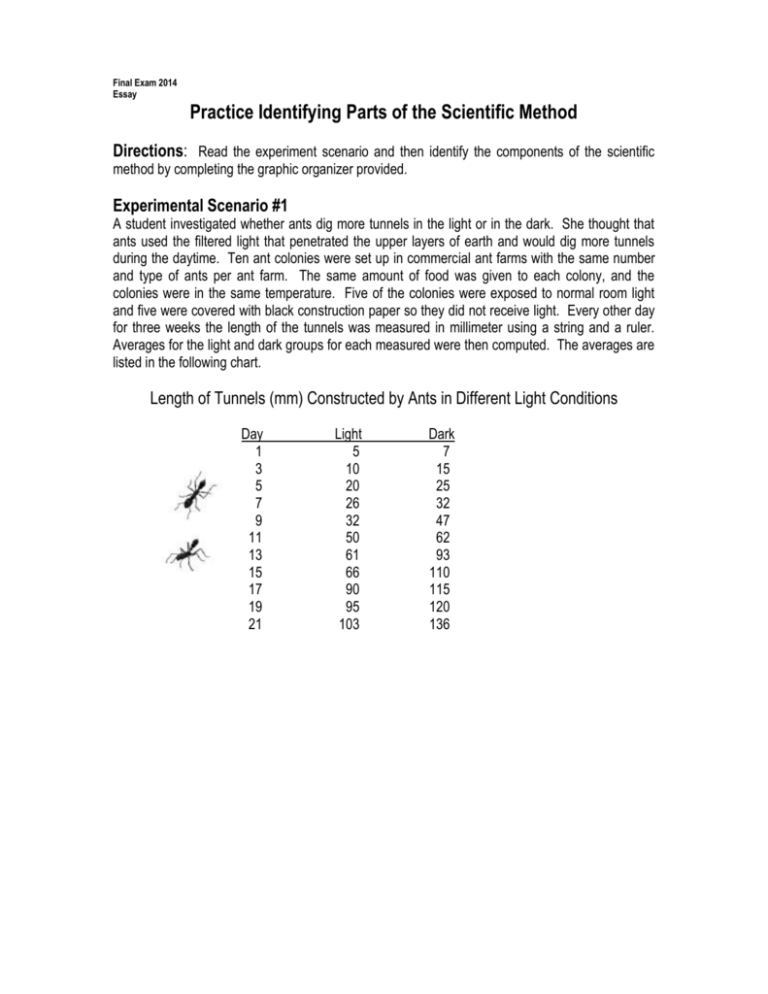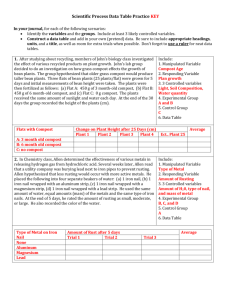Practice Identifying Parts of the Scientific Method Directions
advertisement

Final Exam 2014 Essay Practice Identifying Parts of the Scientific Method Directions: Read the experiment scenario and then identify the components of the scientific method by completing the graphic organizer provided. Experimental Scenario #1 A student investigated whether ants dig more tunnels in the light or in the dark. She thought that ants used the filtered light that penetrated the upper layers of earth and would dig more tunnels during the daytime. Ten ant colonies were set up in commercial ant farms with the same number and type of ants per ant farm. The same amount of food was given to each colony, and the colonies were in the same temperature. Five of the colonies were exposed to normal room light and five were covered with black construction paper so they did not receive light. Every other day for three weeks the length of the tunnels was measured in millimeter using a string and a ruler. Averages for the light and dark groups for each measured were then computed. The averages are listed in the following chart. Length of Tunnels (mm) Constructed by Ants in Different Light Conditions Day 1 3 5 7 9 11 13 15 17 19 21 Light 5 10 20 26 32 50 61 66 90 95 103 Dark 7 15 25 32 47 62 93 110 115 120 136 Final Exam 2014 Essay Practice Identifying Parts of the Scientific Method Directions: Read the experiment scenario and then identify the components of the scientific method by completing the graphic organizer provided. Experimental Scenario #2 A student investigated the effect of radiation on the germination of bean seeds. He thought that exposure to radiation would limit the seeds ability to germinate (grow) much like ultraviolet light causing skin cancer. Three hundred seeds were soaked in distilled water for one hour. They were then divided into three groups. One group was placed in a microwave oven on high for three seconds. Another group was microwaved on high for six seconds. The last group was not microwaved. The seeds were then planted in three separate flats and given the same amount of water. The seeds were then planted in three separate flats and given the same amount of water. The flats were placed in a location with a constant temperature of approximately 27 degrees Celsius. Each day for two weeks the number of seeds that germinated each group was recorded. Total Number of Bean Seeds Germinated after Microwave Radiation Three Seconds of Radiation 54 Six Seconds of Radiation 26 No Radiation 88 Final Exam 2014 Essay Practice Identifying Parts of the Scientific Method Directions: Read the experiment scenario and then identify the components of the scientific method by completing the graphic organizer provided. Experimental Scenario #3 A student investigated the effect of aged-grass compost (fertilizer made from decaying plant material) on the growth of bean plants. She thought that the compost would provide extra nutrients and make plants grow faster. Thirty bean seeds were divided into three groups and planted in different flats (boxes). All seeds germinated after 12 days and were allowed to grow for five days. The flats were ach given the same amount of water and the same amount of light. Flat A was then fertilized with 3month old compost; Flat B was given 6-month old compost; and Flat C was given no compost. At the end of 14 days the height of each plant was measured in centimeters. Final Heights of Bean Plants 3-month old Compost 7.6 5.4 8.2 9.3 8.2 6.9 7.3 9.4 10.2 12.0 6-month old Compost 10.1 9.5 12.1 13.0 8.5 13.1 12.4 11.6 14.8 10.8 No Compost 6.5 7.2 8.4 11.0 6.9 6.8 6.3 10.7 9.9 10.6 Analysis of Experimental Scenarios Scenario #1 Problem/Observation: Effect of light on Ant’s Tunnel Building Question: Do ants dig more tunnels in the light or in the dark? Hypothesis: More tunnels would be made in the light. Experiment: Procedures: 1. Ten ant colonies were set up in commercial ant farms with same number and type of ants per ant farm. 2. Five of the colonies were exposed to light and five were covered with black construction paper. 3. Same amount of food were given to ants in each colony and the colonies were in the same temperature. 4. For three weeks, the lengths of tunnels were measured every other day using a string and a ruler. Independent Variable: Light Dependent Variable: Length of tunnels Controls/constant: amount of food & temperature Control Group: Five colonies without light Experimental Group(s): Five colonies with light Results/Data (Graph): Number of Days Conclusion: The purpose of this experiment was to determine effect of light on ant’s tunnel building. Five colonies of ants were exposed light and five colonies of ants were kept in dark. The data shows five ant colonies in dark dug more tunnel that five ant colonies in light. Therefore the hypothesis is rejected. Analysis of Experimental Scenarios Scenario #2 Problem/Observation: Effect of radiation on the germination of bean seeds Question: Will radiation (microwave) limit the ability of seed germination (growth)? Hypothesis: Radiation (microwave) will limit the ability of seed to germinate (grow). Experiment: Procedures: 1. Three hundred seeds were soaked in distilled water for one hour. 2. They were then divided into three groups. 3. One group was placed in a microwave oven on high for three seconds. One group was placed in microwave oven on high for six seconds. The last group was not microwaved. 4. The seeds were then planted in three separate flats and given the same amount of water. 5. The flats were placed in a location with a constant temperature of approximately 27°C. 6. Each day for two weeks the number of seeds that germinated each group was recorded. Independent Variable: microwave (radiation) Dependent Variable: germination of seed Controls/constant: amount of water and temperature Control Group: seed with no microwave treatment Experimental Group(s): seeds with microwave treatment Results/Data (Graph): Number of Germinated Beans Total number o Bean Seed Germination after Microwave Radiation Time microwave (sec) Conclusion: The purpose of this experiment was to determine the effect of radiation (microwave) on seeds germination. Three groups of bean seeds were treated with different amount of radiation. Three weeks later, number of germinated seeds were counted. The data shows seeds with no microwave treatment germinated most. Hypothesis is accepted. Analysis of Experimental Scenarios Scenario #3 Problem/Observation: Effect of aged-grass compost on growth of bean plants Question: Will aged-grass make plants grow faster? Hypothesis: The aged-grass compost will make bean plants grow faster. Experiment: Procedures: 1. Thirty bean seeds were divided into three groups and planted in different flats (boxes). 2. All seeds germinated after 12 days and were allowed to grow for five days. 3. The flats were each given the same amount of water and the same amount of light. 4. Flat A was then fertilized with 3-month old compost; Flat B was given 6-mtnohg old compost; and Flat C was given no compost. 5. At the end of 14 days the height of each plant was measured in centimeters. Independent Variable: Aged-grass compost Dependent Variable: Height of bean plants Controls/constant: amount of water and light Control Group: Flat C with no compost Experimental Group(s): Flat A and Flat B Results/Data (Graph): Final Height of Bean Plant Effect of Compost on the Growth of Bean Plants Beans Conclusion: The purpose of this experiment was to determine the effect of compost on the growth of bean plants. The data shows beans grew taller in soil with compost and 6-month compost made bean plants grow taller than the 3-month compost. Hypothesis is accepted. Analysis of Experimental Scenarios Point Break Down 50 points total Problem/Observation: 2points Question: 2points Hypothesis: 2points Experiment: Procedures: 5points Independent Variable: 5points Dependent Variable: 5points Controls/constant: 5points Control Group: 5points Experimental Group(s): 5points Results/Data (Graph): Title: 2point Graph: 4points Label: 2points Conclusion: Purpose: 2pts Method: 2pts Hypothesis: 2pts








